In the late 1850’s, Australia is an open and unexplored land full of potential. One of the many Scottish settlers to make his way here is 25 year old Andrew Lothian MacDonald, a fisherman from Edinburgh. He arrives in Adelaide with high hopes and establishes himself. He meets and marries local Australian lass, Ellen and in 1860 their daughter Christina is born. After two years, Andrew finds the Australian weather too hot and humid after Scotland, so they move to Dunedin in New Zealand.
Ten miles northwest of Dunedin, the natural harbour of Port Chalmers is where ships in the area are built and serviced. The next cove is the fishing port of Carey’s Bay where Andrew finds work, life settles and their son, Andrew Lothian Junior is born in 1864. This year too, an electric telegraph line links Christchurch and Lyttleton so people can keep in touch by Morse code. Then in 1865 a telegraph cable crosses Cook Strait and communication between the Islands is possible.
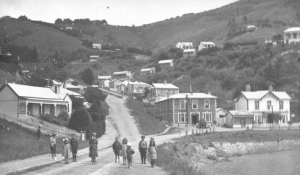
Over several years, with the influx of immigrant ships from Britain, Port Chalmers is growing and busy. In 1873, carriage of supplies to and from the ships is made easier when the country’s first narrow gauge railway from Dunedin opens. In 1874, after a huge gold strike the Mayor of Port Chalmers builds The Crescent Family Hotel in Carey’s Bay. The fine bluestone hotel becomes the town’s social hub where many fishermen enjoy a “return to shore” beer or two. Andrew and his workmates are frequent visitors, along with another regular – Samuel Jones – a mariner in his 20’s recently arrived from Bangor in North Wales. Despite their 20 year age difference, the shared lifestyle forges a solid friendship between Andrew and Samuel. They spend their days at sea and their nights carousing at the hotel. Samuel meets Andrew’s 17-year old daughter, Christina, now a fine, capable young woman working in domestic service nearby. In August 1877, Samuel and Christina marry.
A ‘telephone instrument’ is attached to the wire at Dunedin Telegraph office with another at the Milton office 35 miles away. When voices are heard down the line the newspaper describes it as ‘simply marvellous’. The first telephone office opens at Port Chalmers in 1879 and shipping information can be relayed more quickly to Dunedin.
To follow his work, Samuel and Christina move to the port of Lyttelton near Christchurch. It’s a prosperous settlement, with a new Police Station and Town Hall. Here, the Jones’ welcome their first daughter in 1880 – they name her Mary Grace, after Samuel’s mother. In 1882, Lyttleton’s wharves are the first in the country to trial electric lighting and in July 1883, a new baby is born – Ellen, named after Christina’s mother. Samuel enjoys his beer too much and too often – he becomes an unreliable worker and his waterfront job ends. He finds work as a labourer on the major railway construction in the North Island. He and Christina move Grace and Ellen to Napier and in June 1885, the two little girls have a sister – Emily Alice Christina. Their brother, Edward Owen (Ned) arrives two years later.
Samuel continues to work hard and live hard – he focuses on his pick, his shovel and his beer. Christina raises the children as best she can. They learn an important early lesson – no matter how hard things get in their basic shanty dwelling, their mother will always provide a safe kitchen and a good meal for them. Samuel has no patience for the children – every night before his return from drinking, their mother bustles them into their bunks and reminds them … “Keep very quiet … and stay out of your father’s way”. They cower in their beds as they listen to their father’s violent return to the flimsy hut.
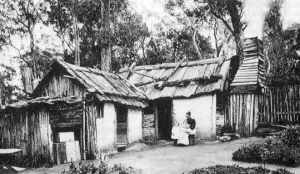
The family moves to a bushland shack near the Waipawa railway. Their brother, Laurence Unity, is born here in 1890. They move to Wellington, where Samuel Llewellyn is born in 1892; they move to the railway site at Ohingaiti in the Rangitikei, where Andrew William is born in 1893. With only basic means, the family’s days are hard, but Christina is stoic and always cares for the children.
By 1896 Samuel despairs at his life and is looking for a way out. When he no longer finds hope at the bottom of a beer glass his eyes venture elsewhere – he decides his fortune lies in the rich Australian goldfields. Blinded by “gold fever” after nineteen years of marriage, he deserts the family.
Now, aged 37, Christina returns with her seven children to Carey’s Bay where Ellen and Andrew Snr take them in. The children’s Uncle Andrew, now 32, has recently married a 22 year old local girl, Selena Gibbs. They live nearby and like his father Andrew Jnr has taken up work in the area’s fishing industry. As a Fish Curer in one of several smokehouses in Port Chalmers, he preserves Ling, Moki and Cod. It’s very popular with buyers because it keeps much longer than fresh fish and it tastes good too. They supply several New Zealand towns and the Australian market.
Christina meets an English boat-builder, John Henry Percy. He’s a widower in need of a wife so she and her children move into his home at Bellevue Place. Now young women, Grace and Ellen resemble Christina – curvy and full figured, but not Emily and Laurie – they are tall and slender, just like their father.
Meanwhile, the “Manapouri” sails from Port Nicholson in Wellington to Australia, carrying Samuel Jones and his dreams of wealth. Once in Sydney, he finds lodgings in Turner Street, Redfern in the heart of the town.
Back in New Zealand, in 1896 Ellen and Emily have cousins when Andrew and Selena’s daughter Irene arrives, then Esma in 1898. A year later, Christina and John have a new baby – Lilian. Now the Percy household is stretched – with seven Jones children, two new parents and a tiny baby. Grace, Ellen and Emily are not impressed – and they haven’t taken to their step-father either.
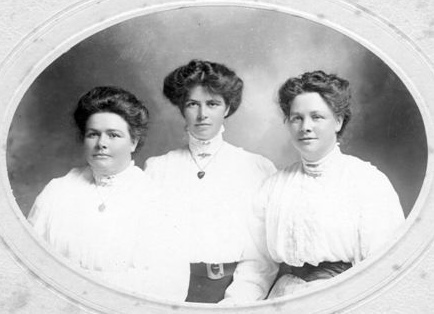
In 1901, Port Chalmers buzzes when Scottish explorer and sea Captain Robert Falcon Scott calls in. He is on reconnaissance for his journey to Antarctica and trek to become the first man at the South Pole.
In 1902, Christina and John welcome their second daughter – Lydia. For Grace, Ellen and Emily the Percy household is now too crowded and they return to live with their MacDonald grandparents. A deep rift forms in the family.
19 year old Ellen, talented in craft and home duties, finds a job as a housekeeper. She meets James Ross, a young baker from neighbouring Sawyers Bay. Andrew and Selena add to their family with the third generation Andrew Lothian, born in 1903 – Emily and Ellen’s first male cousin.

Two years later the girls’ grandmother, Ellen, dies at home. She is buried in a family plot at Port Chalmers cemetery. She is 68. The following month, 21 year old Ellen marries James Ross, at Dockmaster Edward Knewstubb’s home in Port Chalmers. James has a position at Edendale Bakery and the couple move to settle there. On Boxing Day, only a month after they lost their grandmother, their grandfather Andrew Snr dies at home. The family lays him to rest next to Ellen at Port Chalmers cemetery. He is 72.
With both grandparents gone and sister Ellen married, Grace and Emily feel no strong bonds to the Percy household and decide to move away. Grace to a housekeeping job in Christchurch and Emily to Wellington. It feels familiar since she spent part of her childhood here with Christina and her father.
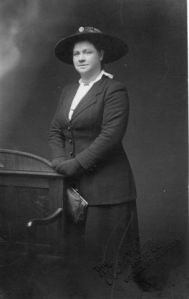
In 1905, Ellen and James’ first son James Alexander is born in Edendale. Now two young Aunts, Grace and Emily are finding their feet. Being a capable housekeeper thanks to Christina’s guidance, Emily finds a job to manage things in a well-heeled Wellington household.
Things at this home are new to Emily and quite up to date – a telephone links the home with the few others who have them and there is a radio. Despite these new devices, Emily’s work as a housekeeper is hard. She must make sure her assigned home is clean, neat and tidy. She has a sink with running water and she cooks on a coal fired stove that she polishes with black graphite. She must carry the meals to the family’s dining room from her basement kitchen, where she eats her own meals on the broad work table. To do the laundry, she fills a copper with water, boils the water, adds the soap flakes she makes by grating a hard bar of soap, then works the clothes by hand to wash them. She uses a hand wringer to force water from the clothes then hangs them on a string line outside to dry.
In Australia, times are difficult and wealth from the goldfields has not yet materialised for Samuel. He takes work on a cattle station in outback South Australia while he awaits his big strike. In January 1907, Emily and Ellen’s father is killed in an accident near Oodnadatta. Samuel Jones is buried in an unmarked grave – he is 55.
Christina marries John Percy and they settle into their lives. NZ agriculture leads an economic boom with its strong exports of frozen meat and dairy products to Britain. Women get into paid work before they marry and the first “Edmonds Cookery Book” is published in Christchurch.
In April 1907, Ellen and James have baby daughter Emily May. The strong Dunedin economy brings more jobs and a housing boom. Young Laurie, now 17, gets a job at Love Brothers as a house painter. The housing boom brings better sanitation to the city and 14 year old Andrew takes up a trade as a Plumber. Llewellyn, now 15, shares his grandfather’s love of the sea and becomes a fisherman at Carey’s Bay.
The prosperity has brought new factories and 20 year old Ned becomes an engineer. Being older and more independent than his brothers, Ned lives with his Uncle Andrew and Aunt Selena a mile or so away. An athletic young man, he follows the interests of his Uncle and takes up the popular sport of competitive rowing. They are members of the Otago Rowing Association where they row together in the same squad. The Association is both socially and athletically active and they greatly enjoy competing in the regular inter-club Regattas held around the region. In fact, their squad recently won the Association’s inaugural White Memorial Fours medal at the Waihola Regatta.
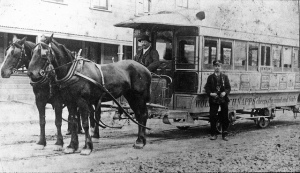
In September 1907 New Zealand is no longer a colony and becomes a dominion within the British Empire. To mark the occasion, Wellington’s newspaper “The Dominion” offers its first issue to readers. Emily enjoys the “Women’s News” section with its household tips and suggested recipe for the evening meal. She rides to her workplace along Wellington’s muddy streets by horse-drawn tram.
This same year, Dr Truby King, a medical activist concerned by New Zealand’s high child mortality rate, promotes support to parents so children have good nutrition to stay healthy and alive. The Royal NZ Society for Health of Women & Children begins and the first Karitane Home for Babies opens in Dunedin, followed by centres in Auckland, Wellington and Christchurch. In December, the modern steamer “Maori” makes its first run between Lyttelton and Wellington as the inter-island ferry. In 1908, the North Island Main Trunk railway opens – the line that took so much of Ellen and Emily’s early years.
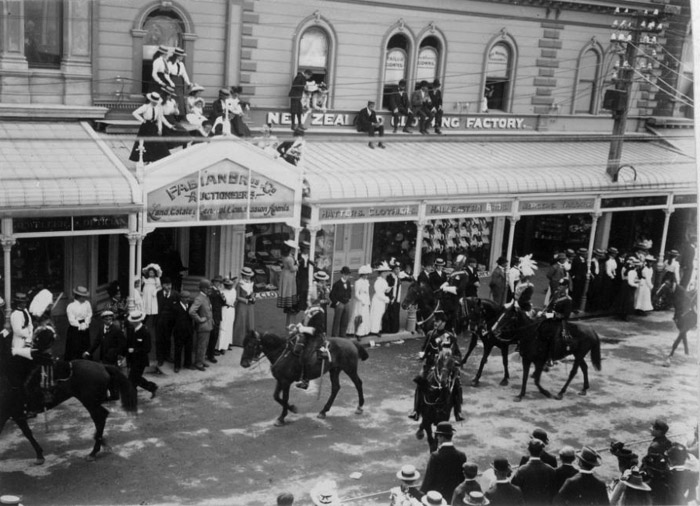
As a plumber in the growing city, young Andrew is busy. He accepts as part of his job that his work takes him to parts of Dunedin where sewers are not yet provided. Precautions in his industry are haphazard and in January 1909 he develops a severe kidney infection. His young body has no strength to fight the relentless illness and, aged only 16, the girls’ youngest brother dies. He is buried with his grandparents in Port Chalmers cemetery.
Later that year, some happy news comes when Ellen and James’ second son George arrives. The Ross family move back to Dunedin and make their home at 22 Scott Street in beachside St Kilda.
In Carey’s Bay the fishing industry flourishes, but it’s tough and risky. Every fishing vessel to leave the harbour faces uncertainty – bad weather, sea hazards and mishaps are all part of a fisherman’s life. Not only are sea voyages hazardous, but the “sharks” on shore can get the better of unwary fishermen too. The Port Chalmers Fishermen’s Co-Operative Society is formed in 1909.
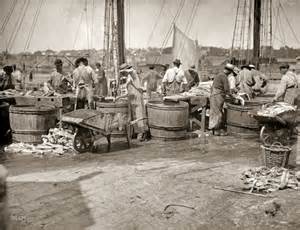
Just like the girls’ grandfather, Llewellyn is born to the seafarer’s life – he loves the fresh wind on his face, the roll of the waves and the heady “rush” when a laden net is hauled in from the sea. As he sails out of the harbour in the dawn light one morning, he breathes deeply to taste the cold salty air. With his lungs full, he glances back at Carey’s Bay and reflects on his life. As he sails out into the wide open sea towards his catch site he lazily lets out his breath. His vessel gently rolls over the building waves – he heads away from the cove – he is never heard from again …
On a blustery day in 1910, the Dunedin crowds excitedly wave from the seashore as Captain Robert Falcon Scott and his crew sail out of the harbour. They have replenished supplies in Port Chalmers and now begin their long voyage south towards the Southern Ocean and Antarctica. The news spreads rapidly around New Zealand by radio and some use the first coin operated telephones.
Laurie, a rower in his leisure time and an active member of the Queen’s Drive Boating Club competes in a “fours” at the Maiden Cup in 1909-1910. Their winning trophy takes pride of place in front of the beaming team in the Championship photo.
In 1911, Grace moves from Christchurch to Wellington to get a job as a housekeeper. She takes rooms on the city’s edge at Clifton Terrace. Both Grace and Emily’s households make their lives easier when their carpet sweeper is replaced by a motorised vacuum cleaner.
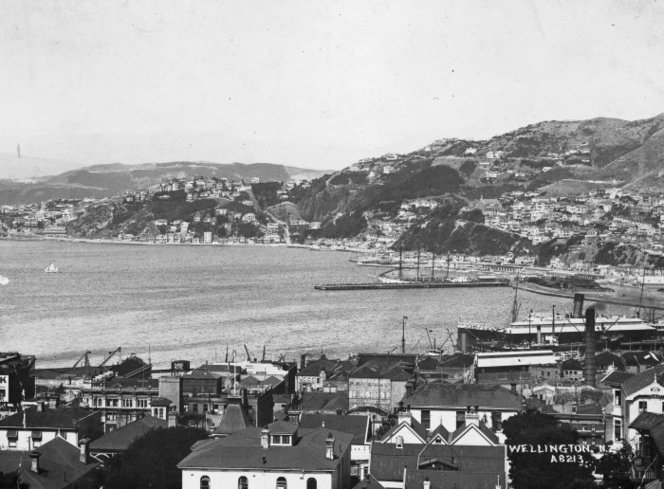
In 1912, tuberculosis is a common and highly contagious but lethal disease in the community – but its chronic cough, fever and night sweats have not yet been addressed by medical science. Even though he’s physically fit, young Ned contracts the cruel disease. Within weeks it ravages his lungs and with no effective treatment, he dies. In Wellington, Emily receives the news with a heavy heart – she’s lost her dearest brother Ned. His close Uncle Andrew takes care of proceedings and at only 25, he is buried next to his younger brother at Port Chalmers cemetery.
Bereft, Emily considers her lot … her grandparents are gone, her renegade father is dead, her mother has a new family, her sisters are distant and her brothers have endured the worst of life’s challenges. Surely things must get better?
In April 1913, Ellen and James’s second daughter, Ellen Isabel, is born. Uncle Andrew and Aunt Selena move to Dunedin’s popular new suburb, St Kilda.
Within a year, the British Empire involves New Zealand in a global conflict. Emily hears the radio news and shudders at the words – a World War. Her young country is not prepared and must suddenly get organised – dress and train an Army, mobilise troops and transport them in their thousands to the war far away in Europe. New Zealanders rally – thousands of young men voluntarily enlist and Grace and Emily support the community war effort in every way they can. New Zealanders’ actions are soundly based on goodwill and national pride.
In 1916, Ellen and James are active in community war efforts too. Like many women, Ellen puts her adept hands towards knitting, sewing and needlework to produce clothing for the troops. At Brown’s Bakery, James provides bread for people running essential services. In February, Ellen gives birth to their youngest daughter, Winnifred Mabel. In Wellington, Aunts Grace and Emily are busy as housekeepers. Grace develops a talent for craft and busies herself with handiwork in her leisure time.
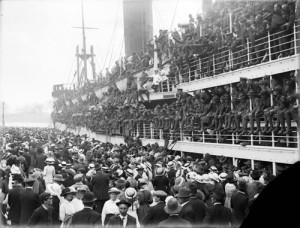
In Port Chalmers, Christina signs the form and stares up at her son – it is Spring in 1917 and Gunner Laurence Unity Jones, New Zealand Artillery, is off to take military training then board a troop ship for “the Front”. He’s excited – but she is frantic. Grace, Ellen and Emily can scarcely bear knowing their only remaining brother is off to risk his life on the other side of the world.
In 1918 Laurie is posted to Scotland to guard Balmoral Castle. After a few weeks, he is transferred to the battlefields of Normandy in France. Gunner Jones serves several months in this horrific theatre of combat. In October 1918, a Field Officer at Normandy pens a brief message to Christina … “Gunner Jones has been wounded in battle, treated at the “Front” and transferred by ship to Royal Victoria Hospital in Southampton, England”. The message stops – there’s no more information. The scant news reaches the distraught family.
In England, Laurie spends several months in Commonwealth Hospital in Devon to recover from facial wounds. After serving 1 year and 218 days, he is discharged from the NZ Army and sails from England on the “Corinthia”. In May 1919 he arrives back in New Zealand and returns to Port Chalmers – to his mother’s home and his house painting.
After four years the World War ends, but it shapes New Zealanders’ lives indelibly. More than 18,000 young Kiwi men are killed in battle, so not only have scores of NZ women lost men from their families, but many keep a sweetheart who has never returned from the War. After such a huge loss, many young women will never marry or have a family.
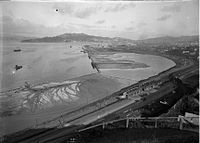
In 1920, Emily’s household obtains a new refrigerator – a marvellous time saver for her as she will no longer need to spend time each day scrubbing the icebox with boiling water so food won’t accumulate in the seams. Some entertainment is provided to New Zealander’s all over the country in 1921 when they enjoy a concert held at Otago University – broadcast on radio for the first time. In 1923 the Railways Department and the Wellington Harbour Board start reclamation of 68 acres of harbour at Thorndon for a new double-track railway, goods yards and sheds.
In 1924, Laurie is awarded the British War Medal and the Victory Medal for his services. Christina and John’s daughter Lilian now 22, marries Lloyd Betten and Lydia 23, weds George Vigers. The Bettens settle 100 miles away in Waimate and invite Christina and John to live in a small bungalow on the property. They happily accept and move within weeks.
In 1928, Emily is housekeeper to a family in central Wellington and takes rooms in Hill Street. Her brother Laurie meets Elizabeth Agnes Johnston Jamieson from Edinburgh. A skilled tailoress, she is 28 (twelve years Laurie’s junior) and is known as “Betty”. The couple marry at Holy Cross Church in St Kilda and through Ellen, Emily learns that they will make their home 20 miles south in Mosgiel. Laurie will continue house-painting and Betty will take in dressmaking. She sews all Laurie’s clothes too, so his suits and coats are apparently rather dapper.
Ellen’s son, Jim works for New Zealand Railways and he transfers to Upper Hutt, north of Wellington to an important railway settlement in the growing Hutt Valley.
In 1930 all the main centres are joined in a telephone network. Now callers can pay a toll to telephone other towns. Of course, this is purely the realm of those who can afford it, so Emily’s communication with her family is still infrequent. The Great Depression hits and jobs across New Zealand become scarce. Luckily for Emily, some families and households still need to be managed while fathers go to their jobs, so she is able to keep up her employment.
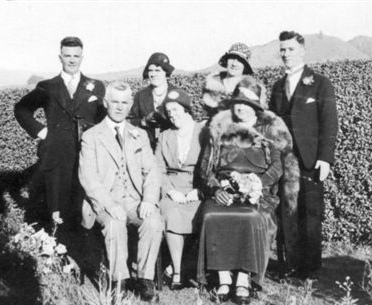
In March 1932, Emily and Grace enjoy a marvellous family gathering in Wellington when their sister Ellen and James visit with their grown up family from Dunedin. They have journeyed north to attend the wedding of their eldest, Jim, to Agnes (Nessie) Anderson in Upper Hutt. These days, travel by train then overnight by ship is arduous, so it’s a momentous occasion indeed. After her upheavals as a girl, Ellen has had quite enough moving around, so she and James are reluctant to leave Dunedin these days. The happy family gather to celebrate Jim and Nessie’s late summer wedding at St David’s, Upper Hutt.
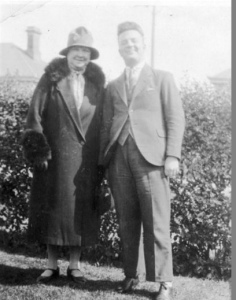
By 1934, Ellen and James are Grandparents to Jim and Nessie’s daughters Nancye Ellen Innes and Winnifred Leslie May. Grace and Emily are pleased to become Grand-Aunts, but they live far from the young girls. In Thorndon, Grace is near the railway station, but travel is still a hardship for her. Now a housekeeper in Khandallah on the northern outskirts of Wellington, Emily has little hope of making family visits. Emily and Grace begin to grow apart.
In 1935, Laurie and Betty have daughter Dorothy. Grandma Christina dotes on Dorothy and the little girl adores her. One Easter on a rare visit to their property at Waimate, Grandma Christina presents Dorothy with a huge chocolate Easter egg – a memorable day indeed for the little girl.
Wellington citizens are pleased when their new railway station is opened in 1937 at Bunny Street. This makes things so much easier, now that the lines to the currently separated stations – Thorndon and Lambton – will be accessible from one central point.
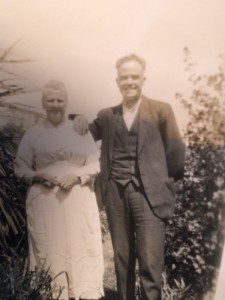
In February 1939, Ellen’s son George marries Kathleen Barker, a 29 year old Englishwoman from Southport. Then in July, Ellen and Emily’s Uncle Andrew dies in Port Chalmers – he is 75. A month later, Britain involves New Zealand in another World War. Life in Wellington changes – Emily sees the harbour become dotted with defence forts and soldiers move into military camps across the city. Numerous families are disrupted and government directives control people’s lives.
Once again, many live with the constant threat of unthinkable loss. People pull together to help deal with their worrying lives. Then, more tragedy strikes the family at the end of the year when Emily and Grace’s six year old Grand-niece Nancye gets severely ill with diphtheria and meningitis in Upper Hutt. She dies within days and the family is hit hard. Then Emily discovers that Grace has diabetes. Always a full figured woman, the disease takes an ongoing physical and emotional toll on Grace and with such constant illness, she becomes cantankerous.

Occasionally, Jim and Nessie bring Winnie the long distance to visit Grace in Wellington. But she is ageing and she never seems pleased with anything, so the visits are uncomfortable. But Winnie admires her Grand Aunt Grace’s craft work all the same. When they visit Grand Aunt Emily though, it’s a much easier time. Just as Christina saw all those years before – Emily has become the total opposite to Grace – tall and slender, well dressed, softly spoken and always serene. How curious that they have become so different …
In late 1942 when she is 82, the girls’ mother Christina, dies in Waimate and is buried at the Waimate Cemetery. Two years later, Ellen’s youngest daughter Winnie marries Les Walker and they settle in Invercargill. In 1944, Ellen has another grandchild when George and Kath have daughter Bernice. Then at the end of the year, Jim and Nessie welcome new daughter Carol Christina Innes to their family.
In 1945, the Second World War comes to an end and once again New Zealanders try to piece their lives back together. Emily, now aged 60, suffers a severe illness – being so slight of frame, the sickness takes a heavy toll on her and she is unwell for several months. Upon her recovery, she becomes a boarder at the home of Maurice and May Wall in Nairn Street, Brooklyn. Emily settles easily at the Wall’s home. Similar to her own family in Dunedin, there is some familiarity here as Maurice Wall is a seaman. Nairn Street is steep and although Emily is mostly recovered from her bout of illness, she is kept in good shape thanks to her walks to and from the city.
By 1946, Grace has become an isolate and is largely out of contact with her family. She dies in Wellington, but requests no ceremony to mark her passing. Dockmaster Knewstubb sees to her burial at Port Chalmers Cemetery – she is 66. Only months later, Emily’s sister Ellen takes a short holiday in Gore, Otago, when she is suddenly taken ill and dies – she is 65. In these few short months, Emily has lost both her sisters.
Three years later in August 1949, Emily’s step-father John Percy dies at age 97. He is buried next to Christina at Waimate Cemetery. In Wellington, Emily’s life continues at Nairn Street. Like many homes in this street, the house has several storeys. Emily’s room is on an upper level, so she must regularly navigate steep narrow stairs – inside to get to the home’s living areas and outside when she uses the bathroom. She forms a strong friendship with Mrs Wall and they, along with shorter term residents, reside together for several years.
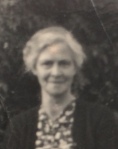
During her years at Nairn Street, Emily’s extended but distant family grows. Her Grand Nephews and Grand Nieces now number seven – in Dunedin George and Kath have Bernice, Neville, Gwenda and Christine; in Invercargill Winnie and Les have Dennis, Geoffrey and Hillary. In 1956, Emily’s niece Dorothy becomes a tutor in English literature and she moves from Mosgiel to Australia to take work at Adelaide University. Emily is delighted that in Wellington her Grand Niece Win, Jim and Nessie’s daughter is a regular visitor. In 1957, Win marries Graham Ritches Weir in Upper Hutt.
In 1958, Emily’s Aunt Selena dies in Dunedin when she is 83; then in January the following year, Ellen’s husband (and Emily’s brother-in-law) James, dies in Dunedin, he’s 81.
Between 1958 and 1962, Emily sees another generation added to the family when she becomes Great Grand Aunt to Win and Graham’s children – Leslie Anne, Mark Ritches and Alison Joy. Of course, “Great Grand Aunt Emily” is a lot for little tongues to grapple with, so Emily is known to her Great Grand Nieces and Nephew as “Dear Aunty” – it’s a simple compromise and the perfect name for their gentle Aunt.
In June 1960, at 75 years old, Emily witnesses another astonishing sight – at the flick of a switch a household can have “television” broadcast right into their home. Then in 1962, her local radio station becomes a national service, when the government owned Radio New Zealand begins. On a winter holiday in Alexandra, Central Otago in 1966, Emily’s nephew George is out on a frozen lake when he falls through the thin ice and perishes in the freezing water – he is 56.
In 1969 and aged 84, Emily moves to Kilmarnock Home at Island Bay in Wellington’s south. She sits in her communal lounge with the other residents and watches as Dougal Stevenson presents the first Network News bulletin broadcast simultaneously around the country. Win and her children are regular visitors to Kilmarnock and Emily enjoys many family Christmases and other occasions at the Weir’s home in Newlands. Emily is a welcome and familiar guest at family gatherings. She and Graham share the same dry sense of humour and enjoy many light-hearted moments with the family. In early 1974, at age 89, Emily becomes frail and she moves to a residential care home at Woburn in the Hutt Valley.
In Mosgiel, now 72, Betty suffers a stroke and is permanently paralysed down her left side. Later that year, she and 85 year old Laurie move to Wollongong in Australia to spend their final years near Dorothy. Upon his arrival in Australia, Laurie is diagnosed with diabetes – a condition undetermined until now.
In June 1975, Emily’s body becomes too weak to continue and shortly before her 90th birthday she dies at Woburn Presbyterian Home. Even at her death, Emily decides not to return to her family in Dunedin. Her Grand Niece Win, makes her arrangements and Emily is farewelled with her close family around her at the Woburn Presbyterian Home’s Chapel. According to her wishes, after her cremation her ashes are spread on the Rose Garden at Karori Crematorium.
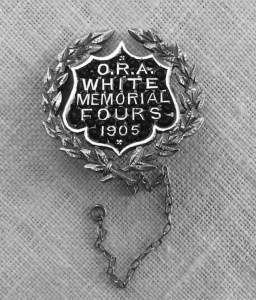
When Emily’s few possessions are collected after her death, Win and the family discover a small gold medal kept carefully by Emily her entire life – embossed “ORA – White Memorial Fours 1905” – her one and only memento of her adored brother Ned.
Born 1st July 1880 and died 1st March 1946, Ellen is my maternal Great-Grandmother.
Born 30th June 1885 and died 2nd June 1975, Emily Alice Christina is my maternal Great-Grand Aunt, my “Dear Aunty”.
==== // ====
Post scripts:
- In 1976, Emily’s dear friend, May Lavinia Wall dies in Wellington.
- In 1978 in Wollongong, Bessie dies of a stroke and months later Laurie undergoes a leg amputation as a result of his diabetes. The next year, 1980, he dies aged 90. After this, it is discovered that whilst Laurie’s wife was referred to as “Betty” by the Jones family in Wellington, she was known to her family in Dunedin as “Bessie”.
Photo sources:
- Carey’s Bay: http://www.careysbayhotel.co.nz/history.html
- Railway hut: http://www.bing.com/images/search?q=railway+settlement+hut+new+zealand&FORM=HDRSC2#view=detail&id=37CE3E389748FE0192ABB58E24F6DEDB3DCB75F5&selectedIndex=103
- Horse Tram: https://c1.staticflickr.com/5/4109/4839950932_1aff6f3bf3_z.jpgq=Wellington+horse+tram&qpvt=Wellington+horse+tram&FORM=IGRE#view=detail&id=85F3AC2DE50517B08EF613D94DDDBC78E7E7E17D&selectedIndex=2q=Wellington+horse+tram&qpvt=Wellington+horse+tram&FORM=IGRE#view=detail&id=85F3AC2DE50517B08EF613D94DDDBC78E7E7E17D&selectedIndex=2q=Wellington+horse+tram&qpvt=Wellington+horse+tram&FORM=IGRE#view=detail&id=85F3AC2DE50517B08EF613D94DDDBC78E7E7E17D&selectedIndex=2
- Lambton Quay 1900: http://hallensteins.snaphire.com/skins/2012/images/1900-parade.jpg
- Fishing catch: http://www.shorpy.com/files/images/4a12861a.preview.jpg
- Wellington 1910: http://natlib.govt.nz/records/22719010?search%5Bil%5D%5Bcategory%5D=Images&search%5Bil%5D%5Bdecade%5D=1910&search%5Bil%5D%5Bsubject%5D=Wellington+City&search%5Bpath%5D=items&search%5Btext%5D=wellington+city+1910
- ‘Troopship departing New Zealand’: http://www.nzhistory.net.nz/media/photo/troopship-departing-new-zealand, (Ministry for Culture and Heritage), updated 28-Jul-2014
- Thorndon reclamation 1925: http://en.wikipedia.org/wiki/Reclamation_of_Wellington_Harbour